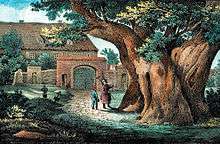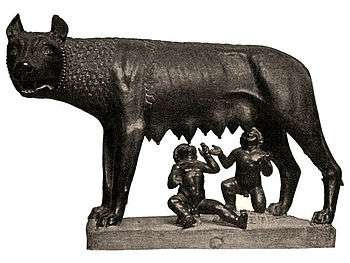Lime tree in culture

The Lime tree or Linden (Tilia) is important in the mythology, literature and folklore of a number of cultures.
Cultural significance
Slavic mythology
In old Slavic mythology, the linden (lipa, as called in all Slavic languages) was considered a sacred tree.[1] Particularly in Poland, many villages have a name "Święta Lipka" (or similar), which literally means "Holy Lime". To this day, the tree is a national emblem of the Czech Republic, Slovakia, Slovenia, and Lusatia. Lipa gave name to the traditional Slavic name for the month of June (Croatian, lipanj) or July (Polish, lipiec, Ukrainian "lypen'/липень"). It is also the root for the German city of Leipzig, taken from the Sorbian name lipsk.[2] The Croatian currency, kuna, consists of 100 lipa (Tilia). "Lipa" was also a proposed name for Slovenian currency in 1990, however the name "tolar" ultimately prevailed.[3] In the Slavic Orthodox Christian world, limewood was the preferred wood for panel icon painting. The icons by the hand of Andrei Rublev, including the Holy Trinity (Hospitality of Abraham), and The Savior, now in the State Tretyakov Gallery in Moscow, are painted on linden wood. Its wood was chosen for its ability to be sanded very smooth and for its resistance to warping once seasoned. The southern Slovenian village of "Lipica" signifies little Lime tree and has given its name to the Lipizzan horse breed.[4]
Baltic mythology
In Baltic mythology, there is an important goddess of fate by the name of Laima /laɪma/, whose sacred tree is the lime. Laima‘s dwelling was a lime-tree, where she made her decisions as a cuckoo. For this reason Lithuanian women prayed and gave sacrifices under lime-trees asking for luck and fertility. They treated lime-trees with respect and talked with them as if they were human beings.
Germanic mythology

The linden was also a highly symbolic and hallowed tree to the Germanic peoples in their native pre-Christian Germanic mythology.
Originally, local communities assembled not only to celebrate and dance under a linden tree, but to hold their judicial thing meetings there in order to restore justice and peace. It was believed that the tree would help unearth the truth. Thus the tree became associated with jurisprudence even after Christianization, such as in the case of the Gerichtslinde, and verdicts in rural Germany were frequently returned sub tilia (Unter der linden) until the Age of Enlightenment.
In the Nibelungenlied, a medieval German work ultimately based on oral tradition recounting events amongst the Germanic tribes in the 5th and 6th centuries, Siegfried gains his invulnerability by bathing in the blood of a dragon. While he did so, a single linden leaf sticks to him, leaving a spot on his body untouched by the blood and he thus has a single point of vulnerability.
The most notable street in Berlin, Germany is called Unter den Linden, named after the trees lining the avenue. In German folklore, the linden tree is the "tree of lovers." See the famous Middle High German poem below.
Hohenlinden (translated as "High linden") is a community in the upper Bavarian district of Ebersberg in which the Battle of Hohenlinden took place; Thomas Campbell wrote the poem Hohenlinden about said battle.
Greek mythology
Homer, Horace, Virgil, and Pliny mention the linden tree and its virtues. As Ovid tells the old story of Baucis and Philemon, she was changed into a linden and he into an oak when the time came for them both to die.
The Scythian diviners take also the leaf of the linden tree, which, dividing into three parts, they twine round their fingers; they then unbind it and exercise the art to which they pretend.
Literary references
- One of the best known poems of the Minnesanger Walther von der Vogelweide is Unter der Linden, which describes a tryst between a maid and a knight under a linden tree.
- A play called The Linden Tree (1947) was written by Bradford-born English novelist, playwright and broadcaster J. B. Priestley.
- Samuel Taylor Coleridge features linden trees as an important symbol in his poem "This Lime-Tree Bower My Prison" (written 1797; first published 1800).
- The short poems (Fraszki) of Polish poet Jan Kochanowski commonly feature linden trees, especially "Na Lipę" ("To The Tilia Tree"), published in 1584. Kochanowski was heavily influenced by the Czarnolas, or the Polish Black Forest, where it is the dominant tree species.
- A poem from Wilhelm Müller's Winterreise cycle of poems is called "Der Lindenbaum" ("The Linden Tree"). In 1827, Franz Schubert wrote the famous song cycle "Winterreise" (D 911) based on these poems.
- Hans Christian Andersen's short story "The Elf of the Rose" mentions a linden tree and its leaves frequently.
- Goethe's The Sorrows of Young Werther features a linden tree throughout the novel, and the protagonist, Werther, is buried under the tree after his suicide.
- In Swann's Way, the first book of Proust's In Search of Lost Time, the narrator dips a petite madeleine into a cup of Tilia blossom tea. The aroma and taste of cake and tea triggers his first conscious involuntary memory.
- "The Three Linden Trees" is a 1912 fairy tale by Hermann Hesse strongly influenced by the Greek legend of Damon and Pythias. The story, set in the medieval period, tries to explain three huge linden trees whose branches intertwine to cover the entire cemetery of the Hospital of the Holy Spirit in Berlin (see The Complete Fairy Tales of Hermann Hesse).
- John Updike's novel The Centaur, like James Joyce in Ulysses, uses myth in an attempt to turn a modern and common scene into something more profound, a meditation on life and man's relationship to nature and eternity. In it Updike parallels the lives of modern characters with the Greek myth in which Chiron's mother Philyra transforms into a linden tree to escape the shame of giving birth to a seemingly mutant half-horse, half-man as a result of her being raped by Kronos.[6]
- The lime tree is referred to in the story "The Man Who Planted Trees" by Jean Giono. The unnamed narrator of the story re-visits a once abandoned and desolate village around which the man referenced by the books title (Elzéard Bouffier) has planted a forest over a period of 40 years. He returns to find by the fountain:
- "I saw that there was indeed a fountain, that it was abundant, and, which touched me most, that someone had planted a lime tree next to it, which might already have been four years old, already thick; an undeniable symbol of resurrection.[7]
- Eminescu's Linden Tree (Romanian: Teiul lui Eminescu) is a 500-year-old silver lime situated in Iași, Romania. Mihai Eminescu reportedly wrote some of his best works underneath this lime, rendering the tree one of Romania's most important natural monuments and an Iași landmark.[8]
In surnames
In Sweden, where the lime tree is named "Lind", the 100 most common surnames in 2015 included at 17 Lindberg (Lime-hill), at 21 Lindström (Lime-stream), at 22 Lindqvist (Lime-twig), at 23 Lindgren (Lime-branch), and at 99 Lindholm (Lime-island).[9]
References
- ↑ Archaeology and Language: Language change and cultural transformation Roger Blench, Matthew Spriggs, p.199
- ↑ Hanswilhelm Haefs. Das 2. Handbuch des nutzlosen Wissens. ISBN 3-8311-3754-4 (German)
- ↑ See Slovenska lipa
- ↑ Snoj, Marko. 2009. Etimološki slovar slovenskih zemljepisnih imen. Ljubljana: Modrijan and Založba ZRC, pp. 234–235.
- ↑ Keeler, Harriet L. (1900). Our Native Trees and How to Identify Them. New York: Charles Scriber's Sons. pp. 24–31.
- ↑ Jonathan Miller, "Off-Centaur", New York Times Book Review, 1 February 1963.
- ↑ "The Man Who Planted Trees - Wikisource, the free online library". En.wikisource.org. Retrieved 2013-10-17.
- ↑ Pettersen, L. & Baker, M. . Romania. Lonely Planet Travel Guide. p. 262.
- ↑ "Efternamn, topp 100 (2015)" (in Swedish). Statistiska centralbyrån (Statistics Sweden). 22 February 2016. Retrieved 26 July 2016.
